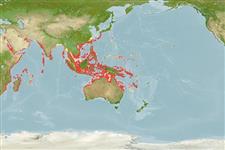Actinopterygii (ray-finned fishes) >
Perciformes (Perch-likes) >
Caesionidae (Fusiliers) > Caesioninae
Etymology: Caesio: Latin, caesius, bluish-grey, 1835; it is the same name given to the silvery metal (Cs) (Ref. 45335). More on author: Cuvier.
Environment / Climate / Range
Ecology
Marine; reef-associated; non-migratory; depth range 0 - 50 m (Ref. 402). Tropical, preferred ?; 31°N - 28°S, 32°E - 167°E (Ref. 402)
Indo-West Pacific: Red Sea, Persian Gulf and East Africa to the Solomon Islands, north to southern Japan.
Size / Weight / Age
Maturity: Lm ? range ? - ? cm
Max length : 40.0 cm TL male/unsexed; (Ref. 402)
Dorsal
spines
(total): 10;
Dorsal
soft rays
(total): 13-15;
Anal
spines: 3;
Anal
soft rays: 10 - 11. Bluish body, pale ventrally; caudal lobe tips, axil and upper base of pectoral fin black. Juveniles with yellow tails and black tips. 4-5 scales on cheek; 18-25 predorsal scales; scaled dorsal and anal fins. Upper peduncular scale rows usually 10 or 11 (9-13); lower peduncular scale rows usually 14 or 15 (13-15). Supra-temporal band of scales interrupted by a thin scaleless zone at dorsal midline. basioccipital process for attachment of Baudelot's ligament absent. Post maxillary process single; posterior end of maxilla blunt (Ref. 1723). Head length 2.6-3.5 in SL; body depth 2.5-3.5 in SL (Ref. 90102).
Found in coastal areas, mainly on or near coral reefs (Ref. 30573). More common along steep seaward reefs than in lagoons (Ref. 9710). Forms large aggregations in midwater on upper edge of steep slopes and around patch reefs, often with other fusiliers (Ref. 90102). Feeds on zooplankton. Oviparous, with numerous, small pelagic eggs (Ref. 402).
Life cycle and mating behavior
Maturity | Reproduction | Spawning | Eggs | Fecundity | Larvae
Carpenter, K.E., 1987. Revision of the Indo-Pacific fish family Caesionidae (Lutjanoidea), with descriptions of five new species. Indo-Pac. Fish. (15):56 p. (Ref. 1723)
IUCN Red List Status (Ref. 115185)
CITES (Ref. 94142)
Not Evaluated
Threat to humans
Harmless
Human uses
Fisheries: minor commercial
More information
ReferencesAquacultureAquaculture profileStrainsGeneticsAllele frequenciesHeritabilityDiseasesProcessingMass conversion
Tools
Special reports
Download XML
Internet sources
Estimates of some properties based on models
Phylogenetic diversity index (Ref.
82805): PD
50 = 0.5020 [Uniqueness, from 0.5 = low to 2.0 = high].
Bayesian length-weight: a=0.01660 (0.00851 - 0.03237), b=3.10 (2.93 - 3.27), in cm Total Length, based on LWR estimates for this species & (Sub)family-body (Ref.
93245).
Trophic Level (Ref.
69278): 3.4 ±0.45 se; Based on food items.
Resilience (Ref.
69278): High, minimum population doubling time less than 15 months (Preliminary K or Fecundity.).
Vulnerability (Ref.
59153): Low to moderate vulnerability (28 of 100) .
